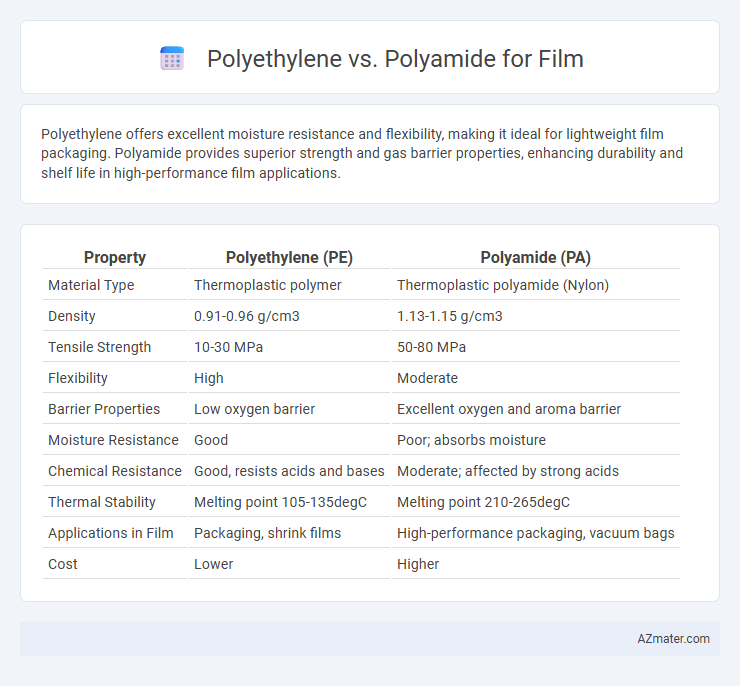Polyethylene offers excellent moisture resistance and flexibility, making it ideal for lightweight film packaging. Polyamide provides superior strength and gas barrier properties, enhancing durability and shelf life in high-performance film applications.
Table of Comparison
| Property | Polyethylene (PE) | Polyamide (PA) |
|---|---|---|
| Material Type | Thermoplastic polymer | Thermoplastic polyamide (Nylon) |
| Density | 0.91-0.96 g/cm3 | 1.13-1.15 g/cm3 |
| Tensile Strength | 10-30 MPa | 50-80 MPa |
| Flexibility | High | Moderate |
| Barrier Properties | Low oxygen barrier | Excellent oxygen and aroma barrier |
| Moisture Resistance | Good | Poor; absorbs moisture |
| Chemical Resistance | Good, resists acids and bases | Moderate; affected by strong acids |
| Thermal Stability | Melting point 105-135degC | Melting point 210-265degC |
| Applications in Film | Packaging, shrink films | High-performance packaging, vacuum bags |
| Cost | Lower | Higher |
Introduction to Polyethylene and Polyamide Films
Polyethylene films, derived from ethylene monomers, are widely used for their excellent moisture resistance, flexibility, and cost-effectiveness in packaging applications. Polyamide films, commonly known as nylon films, offer superior mechanical strength, abrasion resistance, and high gas barrier properties crucial for food preservation. Choosing between polyethylene and polyamide films depends on the required durability, barrier performance, and environmental conditions of the intended use.
Chemical Structure and Composition Differences
Polyethylene (PE) consists of long chains of ethylene monomers, characterized by a simple hydrocarbon backbone with only carbon and hydrogen atoms, resulting in a non-polar, chemically inert structure ideal for moisture resistance. Polyamide (PA), commonly known as nylon, contains repeating units with amide linkages (-CONH-) between carbon chains, introducing polarity and hydrogen bonding capabilities that enhance mechanical strength and barrier properties against gases. The presence of nitrogen and oxygen atoms in polyamide's structure significantly increases its chemical complexity compared to polyethylene's purely hydrocarbon composition, influencing properties like heat resistance, flexibility, and compatibility with other materials in film applications.
Mechanical Properties Comparison
Polyethylene (PE) offers excellent flexibility and impact resistance, making it suitable for applications requiring high elongation and toughness, while polyamide (PA) excels in tensile strength and puncture resistance due to its crystalline molecular structure. PE films typically demonstrate lower tensile modulus and yield strength compared to PA films, which exhibit superior dimensional stability and resistance to wear. The choice between polyethylene and polyamide for film applications depends on the balance needed between mechanical flexibility and strength, with PA favored in demanding environments requiring high durability.
Barrier Properties: Moisture, Gas, and Aroma
Polyamide films exhibit superior gas and aroma barrier properties compared to polyethylene, making them ideal for packaging applications requiring protection against oxygen and odor transmission. Polyethylene films provide excellent moisture barrier performance, effectively preventing water vapor penetration, but their gas barrier properties are lower than polyamides. Combining polyethylene with polyamide layers in co-extruded films leverages the moisture resistance of polyethylene and the gas and aroma barrier capabilities of polyamide for optimized packaging solutions.
Thermal Resistance and Processing Temperatures
Polyamide films exhibit higher thermal resistance than polyethylene films, withstanding temperatures up to 250degC compared to polyethylene's limit of around 120degC. Processing temperatures for polyamide films typically range from 220degC to 270degC, while polyethylene films require lower processing temperatures, generally between 130degC and 200degC. The superior thermal stability of polyamide makes it ideal for applications demanding heat resistance, whereas polyethylene offers easier processing at reduced thermal loads.
Optical Clarity and Surface Finish
Polyethylene films typically offer moderate optical clarity with a slightly hazy appearance, while polyamide films provide superior transparency and a higher gloss surface finish, making them ideal for applications requiring excellent visual appeal. The inherent crystallinity and molecular structure of polyamide result in better light transmission and a smoother surface compared to polyethylene's amorphous regions. Polyamide's enhanced optical clarity and glossy finish are preferred for high-end packaging and lamination where clarity and aesthetic quality are critical.
Flexibility and Toughness
Polyethylene (PE) offers superior flexibility due to its lower glass transition temperature and amorphous structure, making it ideal for applications requiring stretch and bend without cracking. Polyamide (PA), or nylon, provides higher toughness with excellent impact resistance and mechanical strength, especially under stress or repeated use. For film applications requiring a balance, PE is preferred for flexibility, while PA excels where durability and toughness are critical.
Environmental Impact and Recyclability
Polyethylene (PE) films generally have a lower environmental footprint due to their simpler polymer structure, which allows for easier recycling and higher recyclability rates compared to polyamide (PA) films. Polyamide films, while offering superior mechanical and barrier properties, present challenges in recycling processes due to their complex molecular structure and lower prevalence in recycling streams. Advances in chemical recycling and material recovery technologies are improving the sustainability profile of both materials, but polyethylene remains the preferred choice for eco-friendly film applications.
Cost Considerations and Market Availability
Polyethylene generally offers lower production costs and wider market availability compared to polyamide, making it a preferred choice for cost-sensitive film applications. Polyamide films, though more expensive due to their complex manufacturing processes and superior barrier properties, are sought after in specialized markets requiring enhanced strength and thermal resistance. Market demand favors polyethylene for bulk packaging solutions, while polyamide serves niche sectors such as food packaging where performance justifies higher costs.
Best Applications: Choosing Between Polyethylene and Polyamide
Polyethylene offers excellent moisture resistance and flexibility, making it ideal for packaging applications such as food wrap and agricultural films. Polyamide provides superior strength, puncture resistance, and barrier properties against gases, which suits it well for high-performance food packaging and medical films. Selecting between polyethylene and polyamide depends on the specific requirements of durability, barrier performance, and flexibility in film applications.

Infographic: Polyethylene vs Polyamide for Film
 azmater.com
azmater.com